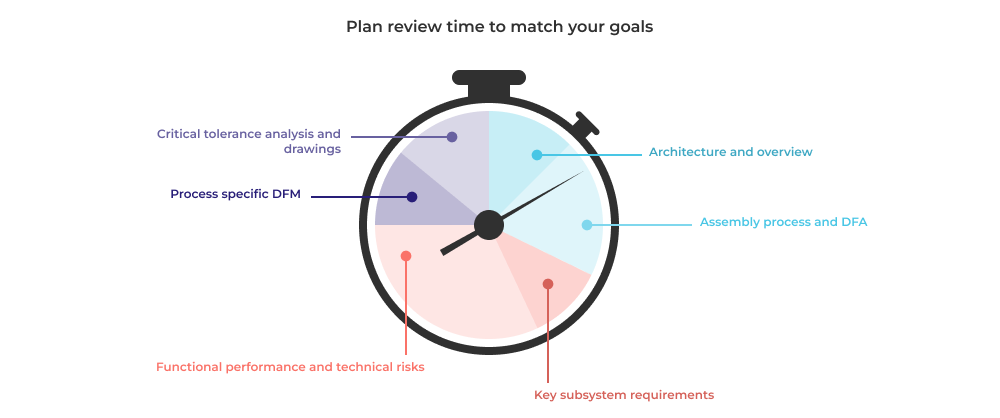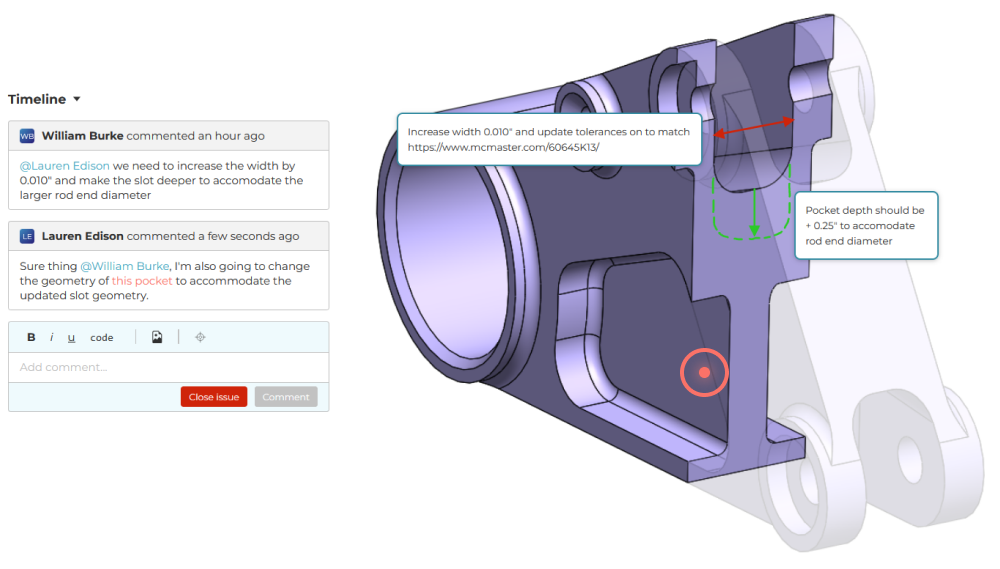This article is part 2 of a 2 part series on engineering design reviews for mechanical engineers. In the first article, we covered how to plan and prepare for your design review. This article covers how to run your reviews effectively, capture actionable feedback that is useful, and close the loop to improve your designs.
Goals
Your preparation for your design review should have you set up nicely to capture high quality design feedback from the right participants. In the remainder of this article, we’ll be focusing on practical guidance to help you achieve a few key goals.
- Capture useful feedback.
- Cover all aspect of the design that need attention (don’t skip anything important).
- Stay organized so you can develop a clear plan of attack after the review is complete.
- Build your design history.
The teams that hit these goals tend to iterate faster, discover issues before they become expensive, resolve more critical design issues per iteration, and deliver better products in less time.
Guide the Discussion
You know better than anyone what you want out of your design review, so don’t be afraid to steer the discussion in that direction. If you are worried about a particular aspect of the design, or some set of risks, feel free to challenge your reviewers to address those areas. Good design reviews are not just feedback sessions, but rather in depth discussions about the tradeoffs and constraints that engineers are contending with. Ideally they should be fun. Consistent and thoughtful moderation can keep everyone focused on the most impactful areas of the design.
PRACTICAL GUIDANCE
Don’t let your design review go off the rails. Here’s a few tips to keep you on track and focused.
-
Watch the clock. Don’t be afraid to cut a line of conversation short or request that reviewers follow up offline. Every minute counts when you have multiple engineers in a review, so be smart with your time.

-
Keep a checklist of your goals. If you prepared correctly, you should have a short list of key review goals. Keep this list handy and make sure your review tackles the big ticket items first before getting lost in the minutiae.
-
Make sure everyone is heard. Like any other group setting, sometimes bigger personalities can take up all the space in the room. Be intentional about soliciting feedback from everyone on the team. Introverts are just as smart as extroverts, but you won’t benefit from it unless you ask.
Capture All Feedback
It may seem obvious, but it’s critical that every piece of feedback is captured during a design review. Otherwise what’s the point? Questions and suggestions may be coming at you left and right, so its important to designate at least one person to capture feedback. We’re pretty biased here, but we like to use issues in Five Flute to capture design review feedback. In fact, we built our SolidWorks add-in to make it easy to create visual issues and markup directly in CAD during remote reviews. Its the fastest way to share visual information and design context while keeping feedback connected to the parts and assemblies being reviewed, so nothing slips through the cracks.
PRACTICAL GUIDANCE
Here are a few considerations when capturing feedback from reviewers.
-
Moderate the discussion. Keep the team focused on the areas of the design that deserve attention. Don’t let the discussion wander into areas where you don’t need feedback.
-
Write everything down. Make sure you designate at least one note taker, or better yet have your team use Five Flute to capture feedback as open issues on the build.
-
Make it visual. You may capture 50+ issues from a single design review. While they may be easy to explain in the review, you want to be sure that you understand them weeks later when its time to address them through redesign. Visual information makes it easy to understand the design context weeks and months later.

-
Withhold judgement. No matter how silly or seemingly unhelpful the feedback, it’s important that it be captured. Constraints may change as you develop and otherwise unhelpful feedback may suddenly become relevant.
Resist the Urge to Redesign
You lined up a great team of reviewers, locked down a meeting time that works for everyone, prepared background information and then spent 30 minutes trying to solve the first cool problem you discovered. Sound familiar? We’ve seen it happen countless times across a variety of hardware projects. Always remember that design reviews are about identifying issues, NOT solving them. It neglects the goals of the review and doesn’t respect the time your reviewers are taking out of their schedule to support your project.

PRACTICAL GUIDANCE
As a moderator of a great design review always remember the following:
- Design reviews are about discovery of issues. Teams that discover more issues per design iteration end up developing better products in a shorter amount of time and at less development cost. Focus on hitting your goals first, covering the design broadly second, and diving deep third.
- Design reviews are not about solutions. No matter how fun it may be, design by committee during a design review is most often unhelpful and never time efficient. Schedule a separate working session or brainstorm to generate new solutions to the issues you discover in your review.
Close the Loop
Now that you’ve addressed all your review goals and captured every bit of feedback its time to close the loop and fix the design. This may take a working session after your review, but the goal is to know what feedback needs to be addressed first and who is responsible for each issue.

PRACTICAL GUIDANCE
Closing the loop ensures high quality output, but it demands a rigorous approach. Be sure to do the following after every design review to get the best results out of your team.
- Leave nothing unassigned. A good design review may reveal several dozen issues worth addressing, and several dozen that can be ignored. Either way you risk letting an issue slip through the cracks unless you assign responsible engineers to each and every one.
- Follow through on every issue. If you trust your review preparation to identify as many issues as possible, simply following through on every issue will make your designs as good as they can be. Many PMs we’ve spoken with opt to have a design review follow up meeting to run down the main issues list after the first week following review. More information is gained during this redesign that can have cross system impacts, so checking in early can keep the design team efficient.
- Be clear about what feedback you are not addressing. Perhaps just as important as being clear about the new solutions you are introducing, it’s equally important to know what issues you decide not to address and the engineering rationale behind your decision. This goes hand in hand with our recommendations to close every issue with a comment in our issue tracking best practices article.
Parting Thoughts
If you are interested in building a system of record for your design review feedback, making better design decisions, and eliminating repeated engineering mistakes, check out Five Flute. It’s the fastest way to share, review, and improve your engineering designs. From engineering drawing reviews to 3D design reviews of complex parts and assemblies, Five Flute is built for modern engineering teams that want to move faster without making mistakes.
You Might Also Enjoy
How to Plan and Prepare for a Mechanical Engineering Design Review
Best Practices for Mechanical Engineering Issue Tracking
Drawings 101 - The Basics of Creating High Quality Engineering Drawings
